Last Updated on May 28, 2023 by a Friendly Gardener
The tropical, evergreen Syngonium podophyllum, commonly called the Arrowhead plant, finds its native habitat in the rainforests of South America. It is a flowering plant that is a member of the Araceae family and belongs to the Aroideae subfamily. It is also known as the Snowhead plant, Goosefeet, American Evergreen, or the African Evergreen Philodendron.
Arrowhead plant types are vining plants, with woody stems, that can grow to lengths of 30 to 60 feet in their native environment. Foliage shape can vary depending on the variety and the maturity of the individual plant with mature plans exhibiting a more lobed shape than younger specimens. As a vining plant, the Arrowhead plant prefers something to latch onto and can be trained to latch onto walls, stakes, poles, and trellises.
These plants feature boast lovely colored leaves with shapes and striations that make them ideal as décor accents in homes and offices. The typical five lobes of the plant’s leaves are said to represent the Feng Shui elements of earth, fire, metal, water, and wood, and lower both anxiety and stress.
As a low-maintenance plant, the Arrowhead plant requires moderate watering, average indoor temperatures, and can tolerate low light. They do enjoy higher humidity, so space humidifiers, pebble trays, misting, or grouping plants may be necessary to keep them happy and thriving. The frequency of watering will depend on the season. Fertilizer can be used once a month during the growing season.
Arrowhead Plant Varieties
There are different types of syngonium, so plant size, variegation patterns, and growth habits can vary significantly. Here are several of our favorites.
1. Albo Variegatum

This striking variety of Arrowhead plant has a name in Latin, ‘Albo Variegatum’, that signifies color diversity. It features dark emerald-green leaves with large, pure white patches. Every leaf shows a unique pattern. This plant is gorgeous when cultivated in a hanging basket or integrated into a green setting.
This variety is beloved and sought-after due to its beauty. It will vine outward, so it will be necessary to decide if you want a hanging vining plant or a bushier plant. To encourage a fuller, bushier appearance, pruning is required. The ‘Albo Variegatum’ does tend to produce some entirely green leaves. To encourage variegation, prune the vines or stem portions that have mature, solid green, foliage to the first variegated leaf.
2. Alboneatum
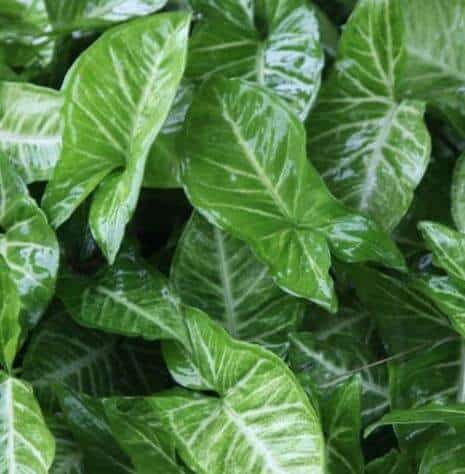
If you prefer an arrowhead variety with large foliage, this cultivar may be the perfect choice. Leaves are triple-lobed with a green background. Cream-hued large veins run down the middle of leaves with smaller veins moving horizontally. Young foliage will measure about 3 x 2 inches, but when the plant reaches maturity, these leaves can reach sizes of 9 x 9 inches each.
3. Emerald Gem
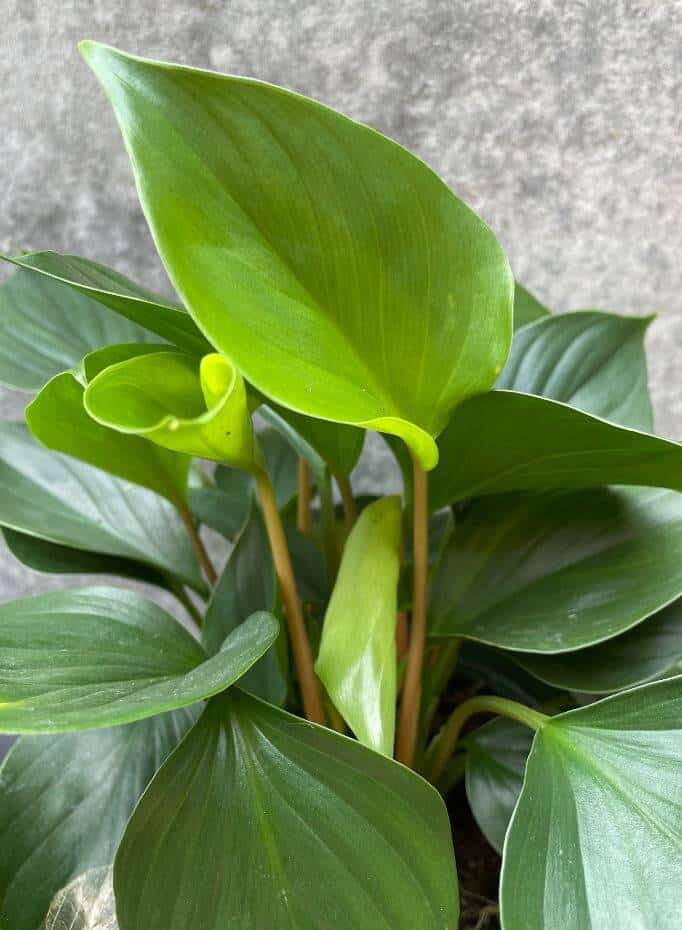
Characterized by a deep emerald hue, the ‘Emerald Gem’ will show light green veining with the occasional white patch on its leaves. Leaf stalks are short in length while leaves are quite large. This cultivar will show the arrowhead shape as a very young plant distinguishing it from other varieties.
4. Gold Allusion
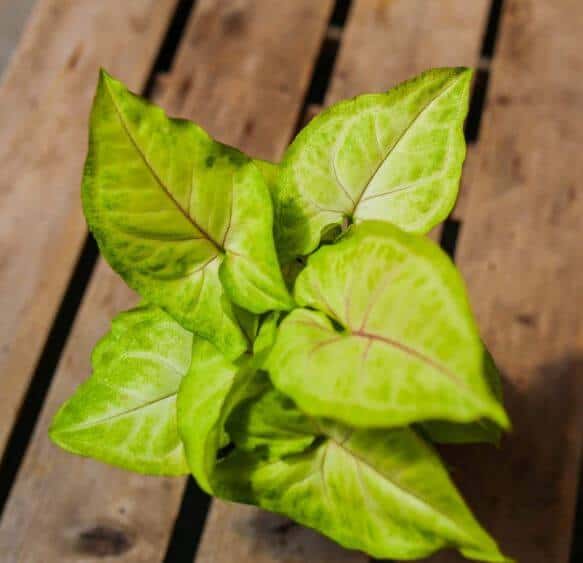
This is a bright-hued arrowhead plant cultivar that produces golden-green leaves. Heart-shaped and medium-sized, leaves are variegated with irregularly shaped green and yellowish designs featuring pink veining. As a vining cultivar, it is best shown in a hanging pot or positioned on a high shelf or piece of furniture. If left in an area with too little light, its coloring may lose intensity.
5. Holly

The ‘Holly’ Syngonium podophyllum is a rare variety with luscious heart-shaped foliage in a silvery whitish hue. Leaves have green edges and green veining. This particular species boasts a compact, thick growth habit that is suckering and not vining.
6. Mini Pixie
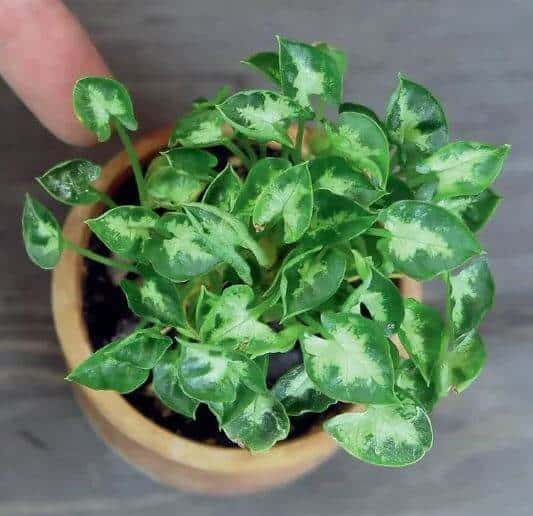
Many people may assume that this is not an arrowhead cultivar due to its petite size, but the ‘Mini Pixie’ is a dwarf variety. Leaves sport attractive patterns in green and gold. It shares some similarities with the ‘White Butterfly’ but in a reduced size. Mini Pixies grow to 3 inches at the most. They should not be exposed to direct sunlight and can be trained with a support structure or be pruned to maintain their shape with only young foliage.
7. Neon Robusta

This arrowhead plant can only be described as spectacular. Foliage grows in a dusty pink color and appears to be covered with a metallic-looking sheen. Young foliage will be green with pink veins and pink hints. Leaf undersides are also pink. Leaves are a generous size. The ‘Neon Robusta’ cultivar is an excellent climbing plant and has a rapid growth habit.
8. Pink Allusion
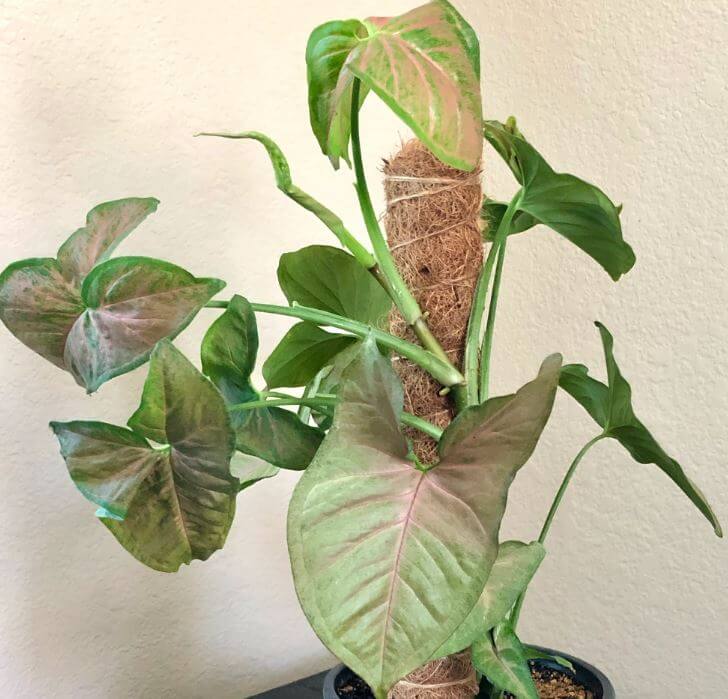
As its name implies, this plant is an arrowhead ivy. Pink Allusion foliage appears rounded and green, with edges that are much darker forming an intriguing border. The veining in all the leaves is pink, hence its name. When this variety of Syngonium has access to bright, indirect light, colors will become more intense. This climber is also referred to as the pink-veined White Butterfly arrowhead plant.
9. Pink Splash
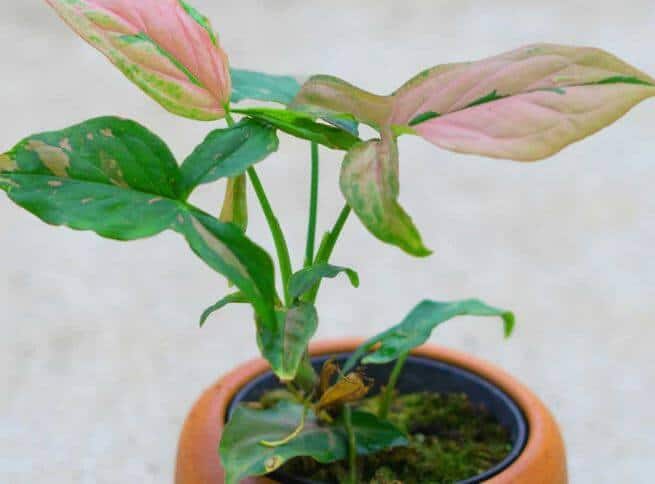
Charming and rapidly growing, the ‘Pink Splash’ is a stunning variety of arrowhead plants. Leaf backgrounds are bright pink with variegations in green. Occasionally confused with the ‘Pink Allusion’, but the ‘Pink Allusion’ has rounder leaves. This happy variety can be cultivated indoors in a hanging basket or a clumping form.
10. White Butterfly

This is probably the most common variety of arrowhead plants. It can grow to heights between 18 and 24 inches. The name comes from the wing shapes that resemble those of butterflies. Foliage is a vibrant green with white veining. Mature plants have leaves that are arrow-shaped with a more creamy-hued veining. New foliage may appear whitish and be more heart-shaped in appearance. This plant does very well when cultivated in hanging baskets or from high perches. You can grow these using support which will afford a more upright, denser growth. Generally, this arrowhead variety will not flower when cultivated indoors.
A Final Thought
Arrowhead plants offer an impressive selection of sizes, shapes, variegation, and colors to choose from. As low-maintenance plants, they are ideal for beginners. These plants are considered toxic to humans and pets, so it’s best to position them where they cannot easily be reached.

